
Steps of Construction of a House by Architects in Lahore, Pakistan
Housing is a fundamental component of a society. It is a very significant factor for humanity throughout the world. Housing is a basic human requirement and necessity as every one of us needs shelter and a place where we can live safely and calmly. A modest, secure and affordable house is what everyone desires to own.
A house is a place of dwelling; it is a building where families live peacefully and serenely; it is a place of shelter. A house protects extremities of weather and keeps the occupants safe from rain, wind, heat and cold.
Lahore is the capital of Punjab province and the second-largest city in Pakistan. Here one will find ancient as well as modern architecture of Lahore. There are many modern developments and well-designed housing schemes at various locations in the city. Some of the high-class and top-ranked housing schemes in Lahore are Defence Housing Authority, Bahria Town, Lake City Housing Scheme, Valencia Housing Society and so on. One may find residential land of different sizes such as 5 Marla plots, 10 Marla plots, 1 Kanal plot, 2 Kanal plots and so on.
These fully developed housing developments feature diverse infrastructure and outstanding facilities that are required for a high-standard lifestyle. Key facilities of these family-oriented housing projects and luxurious housing schemes may comprise security, clean water, the proximity of schools, Allama Iqbal International Airport, community centres, grocery stores, hospitals, banks, commercial areas, mosques, cinema, public transportation, local restaurants, international fast food chains, parks and outdoor activities.
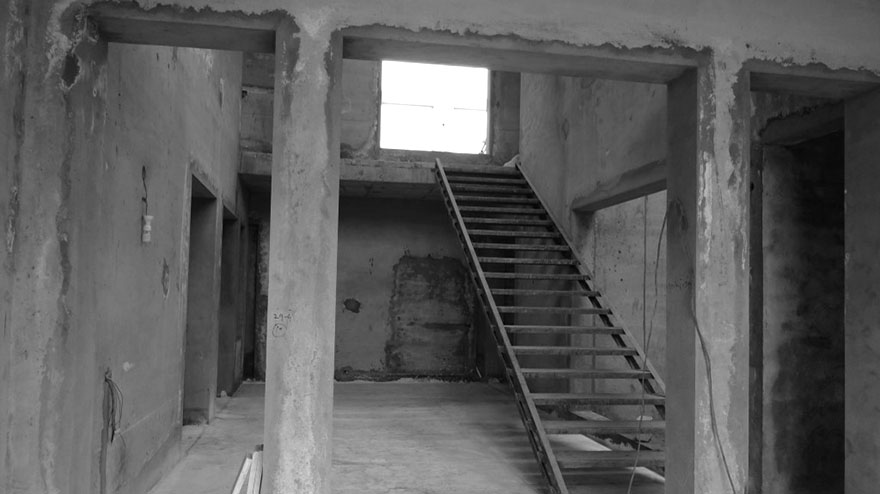
When one desires to own a house and get his new home architecture design done, he purchases land in one of the housing schemes in Lahore. The next step is to hire a reputable architect from the list of architects in Lahore. There are many famous architects in Lahore. They will design and convert your dream house into reality. There are several top architects in Lahore to help you with their design and construction skills.
Architects listen to the client’s brief about what he wants in his new house and what colour scheme he is looking forward to. Architects design the spaces and prepare architectural floor plans fulfilling client’s requirements. After getting the client’s consent, architects move further to make 3d architectural visualization to convey the design concept in coloured 3d architectural renderings.
Architects prepare working drawings that are used by the contractors during the construction at the site. For all kinds of architectural sketches and construction drawings, top architects in Lahore use various design software such as Autodesk AutoCAD (CAD architecture), Autodesk 3ds MAX (3ds Max Architecture), Autodesk Revit (Revit Architecture), Adobe Photoshop, Maya (3d architecture), Google Sketchup (Sketchup architecture), Vali Architects (Sketchup tools and models online platform), Lumion, Unreal Engine architecture, Grasshopper architecture, Rhino architecture, VR architecture (Virtual Reality architecture) and so on.
Architects prepare a large list of drawings coordinating with other engineering consultants such as electrical engineers, structural engineers, MEP engineers, steel engineers and so on. Design firms are equipped with an architectural services department that provides architectural services including architectural design services, and architectural rendering services with the help of architectural technologists and architectural drafters. They design architectural design house plans and all architectural drawings.
Drawings are then submitted by local architects to specific authorities such as the Defence Housing Authority (DHA), Bahria Town, Lahore Development Authority (LDA), Cantonment Board and other relevant departments for approval before starting the construction at the site. Click here to learn more about the list of architectural, structural, sanitation, electrical, and HVAC drawings required for the successful completion of a construction project.
A well-designed home architecture and well-constructed house make a safe, healthy and holistic space for its inhabitants. The client should be aware of the basic construction process before building the house at the site. Top architecture firms in Lahore will guide you through the whole process of construction.
This construction article has been written and composed by a professional team of architects based on their professional experience in collaboration with other consulting engineers, coordinators, contractors, subcontractors and material suppliers to be well familiar with craftsmanship and construction standards. This well-written and thoughtful article will guide the client as well as the construction team through villa architecture and a step-by-step process of constructing a residence project with the involvement of the best architects in Lahore. You will find all the useful information you need to know before building your own house. So let’s begin!
1. START
Contractors, subcontractors, vendors, site supervisor and purchasers are advised not to initiate any work at the site without the following construction drawings and related documents available at the site:
- Approved Submission Drawings
- Whole Set of Construction Working Drawings
- Written Contract Agreement Signed by Client, Contractor & Related Parties
- Bill of Quantities (BOQ)
- Soil Inspection Report
2. CLEAN UP
The site land is prepared for construction by cleaning and getting rid of all weeds and other wild shrubs and plants grown on the site. The site is cleared up of rocks, all unwanted substances, waste materials and other obstacles to make it tidy to commence construction work.
3- CHALKING
Once the site is cleared of unwanted materials, the central lines of the brick masonry walls are marked on the earth within the site boundaries as mentioned on the excavation drawings. These central lines are marked by using chalk. Where there are straight walls in the drawings, they are aligned straight at the site with the help of a piece of cord that is stretched on the wooden or iron rods fixed in the earth according to the drawings and chalked along the length of the cord.
4. EXCAVATION
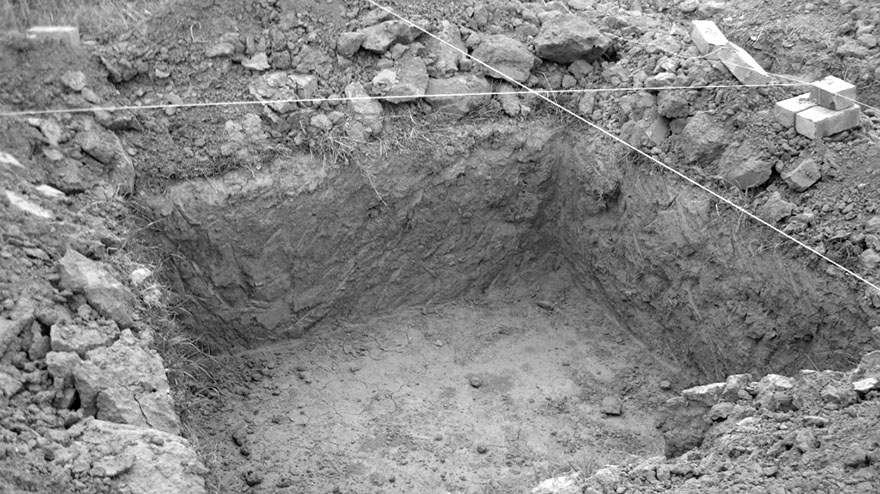
The earth is dug out and excavated to a particular depth from ground level according to the depth shown in the excavation drawing. Excavation is carried out as per drawings as well as any specific instructions provided by the structural engineer of the project. Excavation drawing shows the width and depth of the footing to determine how wide and deep the soil is dug to prepare a base for the foundation lean. There are various types of foundations designed by structural engineers depending on the type and load of building such as raft foundations, strip foundations, piling and others. After a certain level of the earth below road level is achieved, the earth is compressed and compacted with the help of a manual or auto compactor before starting any other activity. The assistant foreman is required to inspect labour and workmanship during this time and record it in a notebook.
5. TERMITE PROOFING
Once the trench is prepared and compacted, termite proofing is required to apply on the earth's surface. As there is a possibility of termites’ attack over the duration of time, all the vertical and horizontal surfaces of the excavated land are sprayed with a powerful, high quality and effective termite control chemical. Instructions of the termite-proof chemical manufacturer are carefully followed while spraying the solution. The chemical prevents the damage caused by termites that may travel inside the structure through the earth in the future. There are various top-quality termite-proofing chemicals available in the market that work best for construction. The warranty of the termite-proof chemical is to be found out from the supplier and recorded before the usage. The assistant foreman is required to inspect and record all activities during this process.
6. EXCAVATION INSPECTION
Once the process of spraying termite-proof chemicals, the excavation of the site is inspected, checked and approved by the project architect and assistant construction manager. This is to make sure excavation is executed according to the plan and there are no discrepancies between drawings and site work.
7. FOOTING PCC BASE
On the excavated and compacted ground, a 4” thick PCC base is laid over. PCC is referred to as Plain Cement Concrete and is made up of a mixture of cement, sand and coarse aggregate. The ratio of cement, sand and aggregate used to prepare PCC is 1:6:12. Aggregate may be brick ballast or broken stone depending on the local availability of the material. The size of the coarse aggregate used in the mixture is generally 1½” wide. The width of the PCC base is determined by the structural engineer. The strength of concrete is determined in units of psi that is pounds per square inch. It is a measurement of the compressive strength of concrete to find out the ability of concrete to bear loads and tolerate compression. A greater psi value means stronger concrete. The strength of the cement concrete mixture used for the building is required to be at least 6000 psi.
8. FOUNDATION
Foundations are laid according to the drawings provided by the structural engineer. There are two types of foundations based on the kind of materials used such as brick masonry foundation and RCC foundation. In a brick foundation, the ratio of cement and sand used as mortar for laying bricks is 1:6. Meanwhile for the plastering of bricks in a brick foundation, the cement and sand ratio is 1:5. RCC foundations are laid according to the footing drawings issued by a structural engineer.
For using bricks in the construction industry, bricks are dipped in water and kept soaked for at least four hours before the start of construction. When bricks are soaked in water, water is absorbed by the bricks and air is released. When soaked bricks are laid on wet mortar for making brick courses, they no longer absorb any water and make a strong bond with mortar. On the other hand, if dry bricks are used without soaking them in the water, they absorb water from the wet mortar. This makes the mortar dry by disrupting the ratio of water in the mortar. Mortar in turn loses strength to a certain extent.
9. FIRST DPC
DPC is referred to as the Damp Proof Course. DPC is a layer of a mixture of cement, sand and aggregate laid on the masonry and acts as a moisture barrier as its name suggests. DPC prevents the moisture absorption that may arise from the earth through brick walls due to capillary action. It restricts the travelling of moisture through brick masonry. There are two types of damp proof courses depending on how they are laid such as horizontal damp proof course and vertical damp course.
The first DPC layer is the horizontal damp proof course laid on the exterior walls of the building below the finished floor level. This DPC layer is 1½” thick. The ratio of cement, sand and aggregate is 1:2:4 for DPC to protect the building well from moisture. Two coats of bitumen are applied on the upper surface of this layer. A polythene sheet having a thickness of 0.008” is placed on top. Brick masonry is continued on it but stopped near reaching the finished floor level where another DPC layer will be laid.
10. SECOND DPC
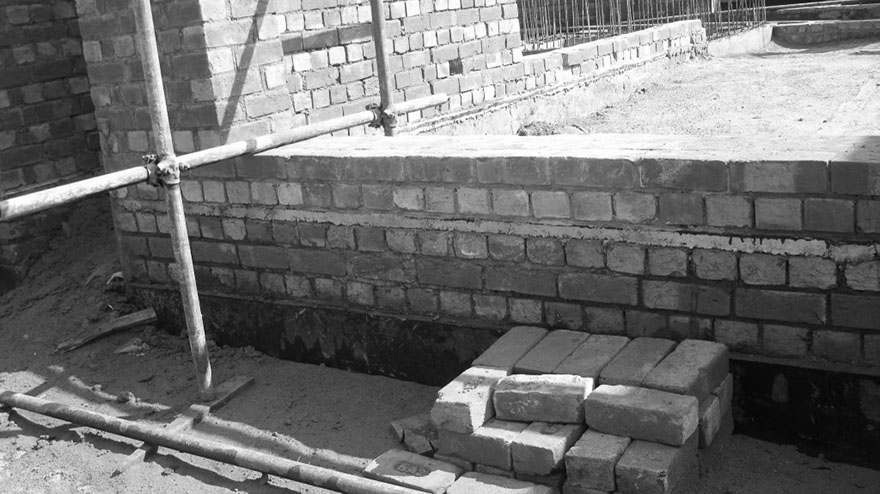
A second DPC is also a horizontal damp proof course laid at the finished floor level (FFL). It is similar to the first DPC layer. The thickness of this course is 1½”. Cement, sand and aggregate ratio is 1:2:4 to act as a moisture barrier. Two coats of bitumen are applied on the upper surface of the second DPC. A polythene sheet with a thickness of 0.008” is laid on the top.
11. VERTICAL DPC
Vertical DPC is a vertical damp-proof course applied on the exterior walls of the building. It prevents the travelling of dampness from sides through brick walls and any other surfaces in contact with one another. The thickness of vertical DPC is ¾”. The ratio of cement and sand is 1:3 for this layer. Two coats of hot bitumen are applied on the DPC layer to obstruct moisture.
12. DPC INSPECTION
Levels of horizontal as well as vertical DPC layers are inspected and approved by the architect and the assistant construction manager. Their responsibility is to make sure levels of three layers of damp proof course are laid correct and are as per the engineering drawings and specifications.
13. EARTH FILL
After damp proof courses are approved by the architect, the earth is dumped and filled in the excavated spaces after laying the foundation up to the finished floor level. Earth fill is executed in 6” layers. Each time, a 6” earth layer is put in the excavated places, it is compacted using the water as well as with the help of compactors according to foreman’s instructions. Earthfilling is to be of good quality and devoid of any termites and other insects.
14. BRICK WALLS UP TO 4’ - GROUND FLOOR
Walls are built by laying bricks in various layers on top of each other up to 4’ in height. Brick masonry under the windows is executed up to the window sill level according to the detailed drawings. Straight edges and plumb lines are used to make sure walls are straight and levelled. Straight edge is a bar or a long piece of metal, wood or plastic having a straight edge used to verify straight surfaces and lines.
A straight edge is placed on the wall and held horizontally. If there are no gaps between the straight edge and the newly built wall, it means the wall is straight. Similarly, a straight edge is held along the wall vertically to make sure the wall is straight vertically.
A Plumb line is a string or a cord that is attached to a small but heavy object at one end to determine if a wall is exactly vertical. The string is held and suspended in a way so the heavy object can dangle freely to check if the surface of the wall is precisely vertical. A plumb line is also known as a plumb bob.
The thickness of the loadbearing wall is 9” while the thickness of the partition wall is 4½”. English bond is used for building the walls. English brick bond is one of the strongest and the most common brick masonry patterns. In this bond, there is a layer or course of stretchers with an alternative course of headers. The size of a common masonry brick is 9” in length x 4½” in width x 3” in depth. Stretcher is the position of a brick placed with its length parallel to the surface of the wall. The header is the orientation of a brick placed widthwise on the face of the wall.
The ratio of cement and sand in the mortar used for 9” thick brick walls is 1:5 and that for 4½” thick brick walls is 1:4. All the bricks are submerged in water for at least four hours before brickwork. Brickwork for external walls is executed from outside.
15. DOOR FRAMES - GROUND FLOOR
Once brick masonry is complete up to 4’ height, wooden door frames are installed on the ground floor according to the drawings.
16. BRICK WALLS UP TO 7’ - GROUND FLOOR
After installing the wooden door frames, brick masonry is continued in courses up to 7’ height from the proposed finished floor level. They are made levelled and straight with the help of tools such as straight edges and plumb lines. Mortar used for 9” thick brickwork consists of cement and sand in a 1:5 ratio. Mortar used for 4½” thick brickwork is composed of a mixture of cement and sand with a ratio of 1:4. Bricks are placed in water for at least four hours before starting brick masonry work. Bricks for external walls are laid from the external side.
17. LINTELS & SHADES - GROUND FLOOR
Lintels are constructed on the top of openings of windows and doors to support the load of brick masonry work above windows and doors. These lintels and sunshades (chhajja) over the windows and doors are built by following the structural drawings and specifications issued by a structural engineer. Lintels are made of RCC which is reinforced cement concrete consisting of cement, sand, aggregate and steel bars, poured into the formwork. Lintels are constructed with shoulders of 9” extending beyond the sides of the openings. There is a difference in the structural design of a lintel for a corner window. In a corner L-shaped window, the lintel extends more keeping in mind the load and stability of the structure.
18. BRICK WALLS UP TO 10’ - GROUND FLOOR
After the concrete is poured into the formwork for constructing lintels and shades above doors and windows, brick masonry is continued in layers up to 10’ height from the proposed finished floor level. They are made levelled and straight with the help of tools such as straight edges and plumb lines. Mortar used for 9” thick brickwork consists of cement and sand in a 1:5 ratio. Mortar used for 4½” thick brickwork is composed of a mixture of cement and sand with a ratio of 1:4. Bricks are placed in water for at least four hours before starting brick masonry work. Bricks for external walls are laid from the external side.
19. SHUTTERING – GROUND FLOOR
A temporary structure is built using metal or wooden poles to support a working platform for labourers, workmen and materials used during construction. This process of making this structure is known as scaffolding. A scaffold supports the shuttering as well as construction workers. It provides a safe and durable platform so workmen can perform their tasks easily and reach to required heights. Shuttering or formwork is assembled and supported by a scaffold. Shuttering is a way of making a mould in which fresh and wet concrete is poured to take the shape of the mould when it sets and hardens. Wooden boards made of sheesham wood are generally used for shuttering. All wooden boards are placed side by side. Gaps between them are sealed by using paper or metal sheets.
There is another type of shuttering used in construction known as metal shuttering. Metal shuttering is recommended by the architects in order to achieve better quality. For metal shuttering, oiling and taping are done on metal boards to prevent honeycombing and leakage as per the instructions by the foreman.
20. STEEL LAYING - GROUND FLOOR
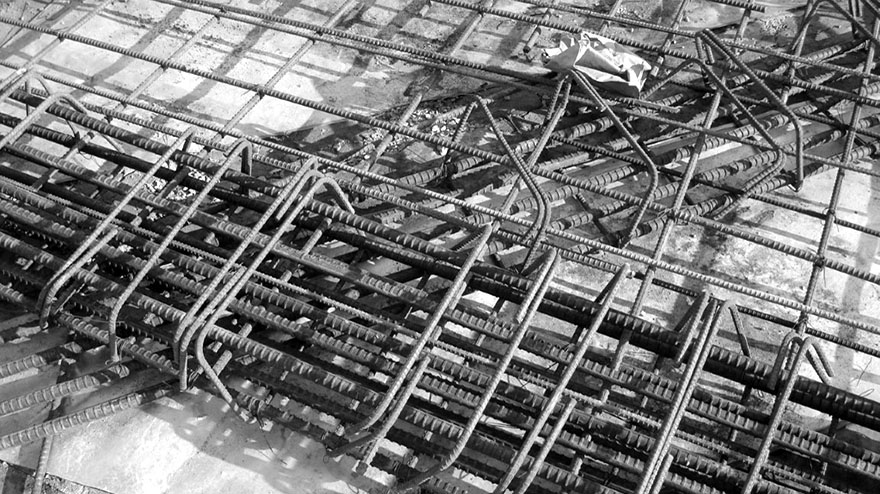
Reinforced steel bars (sarya) are laid according to the structural drawings and specifications provided by a structural engineer. Steel rebars are placed on the shuttering boards at around 1” distance. The specific distance is achieved by placing particular sizes of rebar spacers or rebar chairs placed at intervals. Spacers are tied up with reinforcement on the instructions of the assistant foreman. Reinforced steel bars are placed near the bottom of the RCC slab as well as close to the top by following the structural drawings where the diameter, type and spacing of the steel bars are mentioned in detail. A steel grid or mesh is built by placing and connecting rebars on the x-axis and y-axis. These rebars are interconnected strongly with steel wires.
21. ELECTRICAL CONDUCTING – GROUND FLOOR
Specific PVC electrical conduits are installed in the steel mesh of reinforced steel bars following electrical drawings provided by an electrical engineer. The internal diameter of conduit pipes used for all kinds of electrification works except for air conditioning is ¾”. Internal diameter of electrical conduits used for air conditioning is 1”.
22. SHUTTERING, STEEL & CONDUIT INSPECTION
Shuttering, reinforced steel mesh, electrical conduit pipes and their levels are inspected and approved by the architect, structural engineer and assistant construction manager before pouring the concrete.
A cube test is highly recommended before pouring to determine the compressive strength of concrete using a mould, base plate and compressive strength test machine. Compressive strength test is performed on day 7, day 14 and day 28 of cube curing.
The assistant foreman needs to make sure all the materials required for making the concrete mixture are available at the site at least a day before pouring the concrete on the shuttering to form the RCC slab.
23. SLAB POURING - GROUND FLOOR
A mixture is prepared by mixing cement, sand and aggregate in a 1:2:4 ratio. The wet mixture is then poured into a steel grid formed over shuttering or formwork. The surface of the concrete is levelled using a vibrator and wooden levelling gauge. A concrete vibrator is used to remove air bubbles and air pockets from wet concrete to formulate a solid and perfect slab. The top surface of wet concrete is made smooth using a hand trowel. The foreman and assistant foreman are required to stay at the site during this time.
24. SLAB POURING INSPECTION
During the process of pouring concrete, the architect, assistant construction manager and foreman need to remain at the site to inspect all activities and record them in writing.
25. CURING OF SLAB - GROUND FLOOR
After pouring concrete, no activity will be commenced on the slab for at least three days. RCC slab is cured with water to achieve optimum strength, water resistance and durability. Curing is a method in which concrete is watered and kept wet for several days. Curing of the ground floor slab is started after 24 hours of pouring and is done for twelve days. The time to start the curing process of concrete varies depending on when the concrete surface starts to dry, lose water and go through shrinkage.
The dryness of concrete depends on heat from the sun, wind, climate, humidity and temperature of concrete. When water is added to the dry mixture of cement, sand and aggregate, hydration of cement begins instantly and heat is produced in the concrete. To achieve proper strength of concrete, proper hydration of cement is required. This whole process will form a solid synthetic rock known as concrete.
26. REMOVAL OF SHUTTERING - GROUND FLOOR
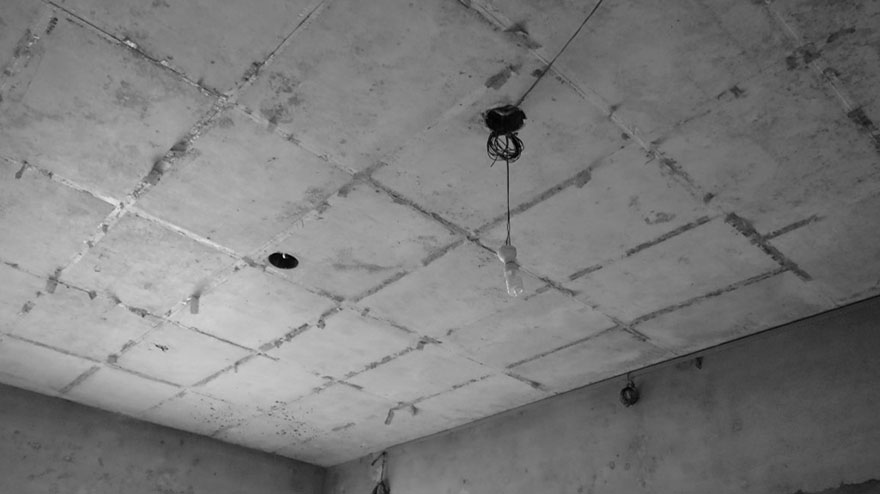
Shuttering boards from the ground floor slab are removed after curing the concrete slab for twelve days or more on the instructions of the assistant foreman. All shuttering boards are stacked together carefully and stored well in a secure place.
27. CEILING PLASTERING - GROUND FLOOR
Under surface of the slab is covered with cement and sand plaster. The ratio of cement and sand in the plaster used for the ceiling is 1:3. Sand to be used for plaster is cleaned well before adding it to the mixture. The thickness of the plaster is 3/8”.
28. WALL CHISELING - GROUND FLOOR
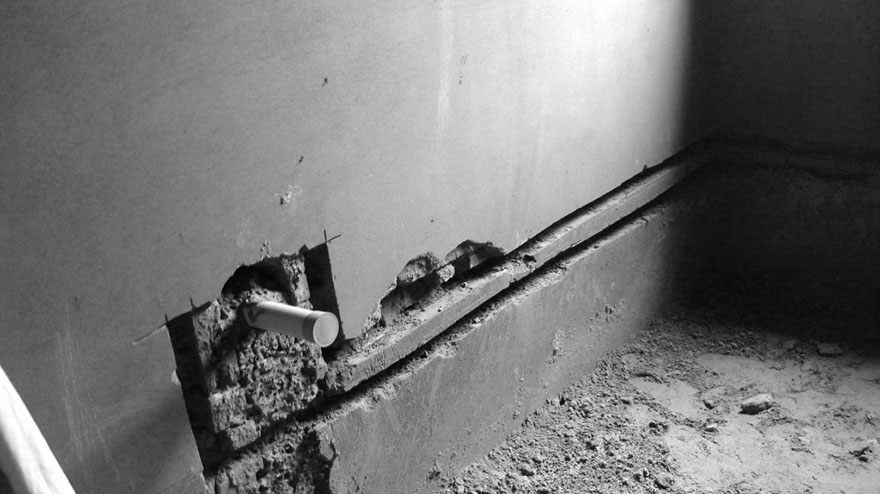
Walls are chiselled and grooves (jhari) are made to accommodate utility services such as gas and electrical pipes as well as spaces made for electrical boxes. The assistant foreman is required to make sure that spaces to be chiselled are marked on the walls with the help of chalk following the drawings. These marks are inspected and checked by an architect before chiselling. Chiselling is not to be started without checking chalk marks. After chiselling, service pipes are placed inside the grooves and spaces. The architect inspects the pipe network before covering and filling it with plaster.
29. WALL PLASTERING - GROUND FLOOR
The walls of the ground floor are plastered and given a smooth surface. The ratio of cement and sand used for the plaster to be applied on internal walls is 1:4. Thickness of the plaster is ½” to prepare a base to take wall finish such as paint.
30. KITCHEN COUNTER & BATHROOM VANITY SLABS

The kitchen counter, bathroom and powder vanity slabs are poured at specified heights per drawings and specifications. A 4” high ledge (thurhi) is provided at the base of slabs in the kitchen. Kitchen cabinets will sit on this base at a later stage. Walls and a 4” high ledge in the kitchen are plastered with ½” thickness to prepare a base for final surface finish.
31. SECOND TERMITE PROOFING
A 6” wide trench is dug into the ground around all the brick masonry on the ground floor. A good quality and effective termite control chemical is sprayed into the trench as per the manufacturer’s instructions to prevent termite attacks on the building.
32. PUBLIC HEALTH - GROUND FLOOR
Some effective waterproofing is done according to the drawings before starting public health work. Areas to accommodate the sanitary pipes are marked on the wall with chalk as per sanitary drawings. The marks are inspected by the architect before starting chiselling. Sanitary pipes are placed in the chiselled spaces. The architect inspects the position of all the sanitation pipes. PPRC water supply pipes or equivalent pipes are used. UPVC sewer water pipes or equivalent pipes are used. Effective quality of local RCC pipes are used for main sewer lines. Pressure and water tests are carried out to make sure there is no water leakage in the presence of the assistant construction manager who approves the test results before filling the chiselled grooves.
33. FLOORING - GROUND FLOOR
The earth is compacted. On the top of the compacted earth, a 12” thick layer of a mixture of sand and soil (kassu) is spread evenly. This layer is compacted well. A 4” thick layer of brick ballast is laid over the kassu layer. The brick ballast layer is compacted manually. All utility lines are re-inspected by the foreman before preparing the PCC base for flooring. A 1½” thick layer of PCC is poured on the brick ballast layer. This PCC layer acts as a base to take floor tiles.
The ratio of cement, sand and aggregate in the PCC base is 1:2:4. Approved floor tiles are then laid on the PCC base with mortar as per drawings and instructions by the architect. The ratio of cement and sand used in the mortar is 1:6. Tiles are placed on the floor with or without the spacers as per the architect’s instructions. An accurate level of the tiles is achieved using a level with a bubble. When tiles are laid, grouting is done by filling the tiny gaps between the tiles with a specific grout.
34. KITCHEN COUNTERTOP - GROUND FLOOR
¾” thick countertop of a particular material such as marble, granite or some other material is fixed on the kitchen slabs prepared earlier.
35. BATHROOM VANITY TOP - GROUND FLOOR
¾” thick countertop of a particular material such as marble, granite or some other material is fixed on the bathroom vanity slabs that were prepared earlier.
36. KITCHEN TILING - GROUND FLOOR
Particular floor tiles are laid on the top of a 1½” thick PCC base with mortar following the drawings and design details. The ratio of cement and sand used in the mortar is 1:6. Accurate level of the tiles is achieved using a level before fixing the tiles in the mortar. When tiles are laid, grouting is done by filling the tiny gaps between the tiles with a specific grout. A slope is made towards the proposed floor trap while laying the tiles so water may automatically travel towards the floor trap and not stay stagnant.
37. BATHROOM & POWDER ROOM TILING - GROUND FLOOR
Particular floor tiles are laid on the top of a 1½” thick PCC base with mortar per the drawings and design details. The ratio of cement and sand used in the mortar is 1:6. Accurate level of the tiles is achieved using a level before fixing the tiles in the mortar. When tiles are laid, grouting is done by filling the tiny gaps between the tiles with a specific grout. A slope is created towards the proposed floor trap during tile installation to ensure that water naturally flows towards the trap, preventing it from remaining stagnant.
38. KITCHEN FIXTURES - GROUND FLOOR
The cooking range, hob, hood, refrigerator, freezer, water mixers and other kitchen accessories are selected and approved by the architect and client. All the fixtures are installed and fixed following the architectural drawings.
39. BATHROOM & POWDER ROOM FIXTURES - GROUND FLOOR
The wash basin, water closet, shower cabin, shower head, water mixers, shattaf (Muslim shower), toilet paper holder, towel rod, towel rack, floor trap, soap dish and other bathroom accessories are selected and approved by the architect and client. All the fixtures are installed and fixed following the architectural drawings.
40. STAIRCASE
The staircase is constructed in reinforced concrete as per architectural and structural drawings. The ratio of cement, sand and aggregate in RCC steps is 1:2:4. The Type and diameter of rebars as well as the distance between reinforced steel bars is determined by a structural engineer. Treads and risers are constructed according to architectural drawings.
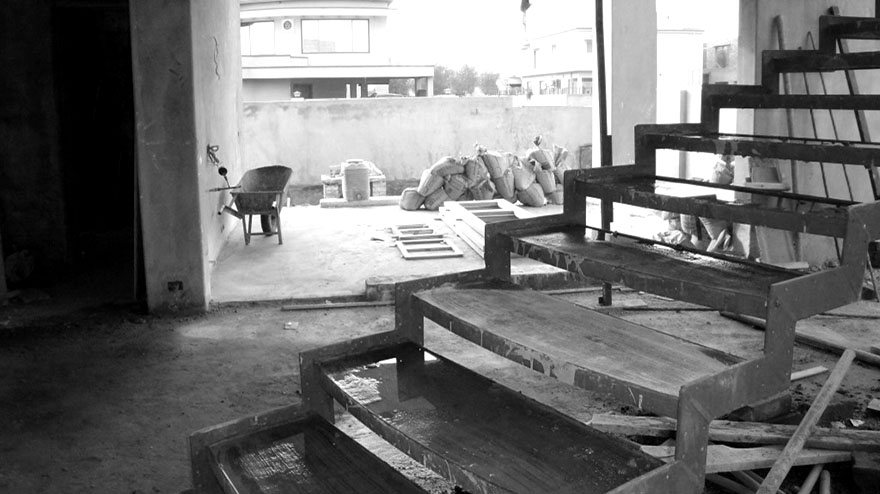
The staircase structure is also prepared in steel. Where the staircase is built in steel, sometimes the first two steps are made in concrete going from the lower level to the upper level.
41. BRICK WALLS UP TO 4’ - FIRST FLOOR
Walls are built by laying bricks in various layers on top of each other up to 4’ in height. Brick masonry under the windows is executed up to the window sill level according to the detailed drawings. A Straight edge and plumb line are used to make sure walls are straight and levelled. The thickness of the loadbearing wall is 9” while the thickness of the partition wall is 4½”. English bond is used for building the walls. The ratio of cement and sand in the mortar used for 9” thick brick walls is 1:5 and that for 4½” thick brick walls is 1:4. All the bricks are submerged in water for at least four hours before brickwork. Bricks for external walls are laid from the external side.
42. DOOR FRAMES - FIRST FLOOR
Once brick masonry is complete up to 4’ height, wooden door frames are installed on the ground floor according to the drawings. Metal frames are installed for doors in the servant quarter and servant bathroom.
43. BRICK WALLS UP TO 7’ - FIRST FLOOR
After installing the wooden door frames, brick masonry is continued in courses up to 7’ height from the proposed finished floor level. They are made levelled and straight with the help of tools such as a straight edge and plumb line. Mortar used for 9” thick brickwork consists of cement and sand in a 1:5 ratio. Mortar used for 4½” thick brickwork is composed of a mixture of cement and sand with a ratio of 1:4. Bricks are placed in water for at least four hours before starting brick masonry work. Bricks for external walls are laid from the external side.
44. LINTELS & SHADES - FIRST FLOOR
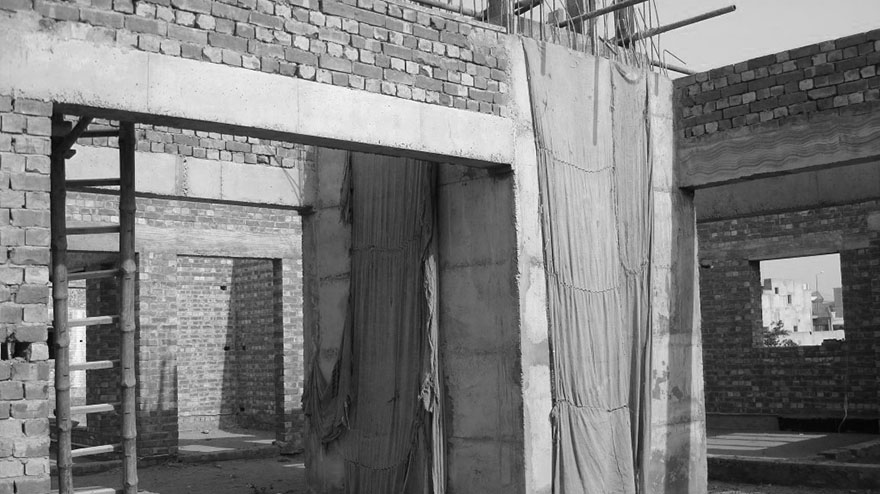
Lintels are constructed on the top of openings of windows and doors to support the load of brick masonry work above windows and doors. These lintels and sunshades (chhajja) over the windows and doors are built by following the structural drawings and specifications issued by a structural engineer. Lintels are made of RCC which is reinforced cement concrete consisting of cement, sand, aggregate and steel bars, poured in the formwork. Lintels are constructed with shoulders of 9” extending beyond the sides of the openings. There is a difference in the structural design of a lintel for a corner window. In a corner L-shaped window, the lintel extends more keeping in mind the load and stability of the structure.
45. BRICK WALLS UP TO 10’ - FIRST FLOOR
After the concrete is poured into the formwork for constructing lintels and shades above doors and windows, brick masonry is continued in layers up to 10’ height from the proposed finished floor level. They are made levelled and straight with the help of tools such as straight edge and plumb line. Mortar used for 9” thick brickwork consists of cement and sand in a 1:5 ratio. Mortar used for 4½” thick brickwork is composed of a mixture of cement and sand with a ratio of 1:4. Bricks are placed in water for at least four hours before starting brick masonry work. Bricks for external walls are laid from the external side.
46. SHUTTERING - FIRST FOOR
A temporary structure is built using metal or wooden poles to support a working platform for labourers, workmen and materials used during construction. This process of making this structure is known as scaffolding. A scaffold supports the shuttering as well as construction workers. It provides a safe and durable platform so workmen can perform their tasks easily and reach to required heights. Shuttering or formwork is assembled and supported by a scaffold. Shuttering is a way of making a mould in which fresh and wet concrete is poured to take the shape of the mould when it sets and hardens. Wooden boards made of sheesham wood are generally used for shuttering. All wooden boards are placed side by side. Gaps between them are sealed by using paper or metal sheets.
There is another type of shuttering used in construction known as metal shuttering. Metal shuttering is recommended by the architects in order to achieve better quality. For metal shuttering, oiling and taping are done on metal boards to prevent honeycombing and leakage as per the instructions by the foreman.
47. STEEL LAYING - FIRST FLOOR
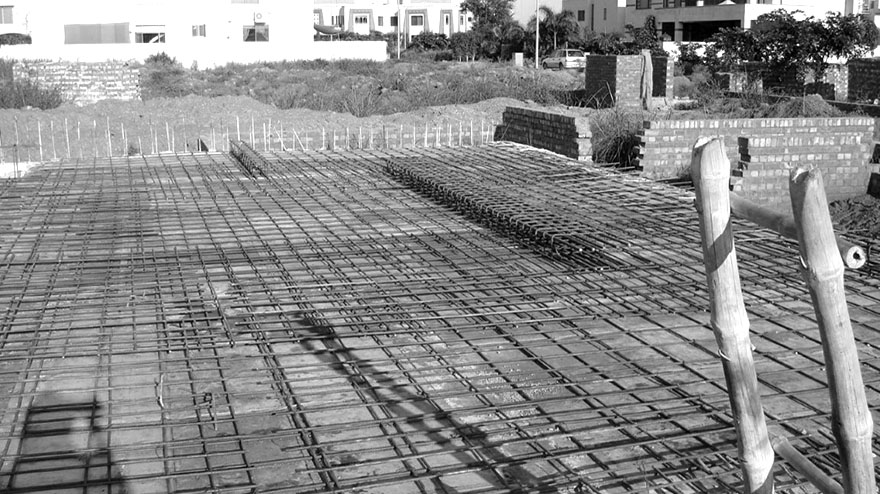
Reinforced steel bars (sarya) are laid according to the structural drawings and specifications provided by a structural engineer. Steel rebars are placed on the shuttering boards at around 1” distance. The specific distance is achieved by placing particular sizes of rebar spacers or rebar chairs placed at intervals. Spacers are tied up with reinforcement on the instructions of the assistant foreman. Reinforced steel bars are placed near the bottom of the RCC slab as well as close to the top by following the structural drawings where the diameter, type and spacing of the steel bars are mentioned in detail. A steel grid or mesh is built by placing and connecting rebars on the x-axis and y-axis. These rebars are interconnected strongly with steel wires.
48. ELECTRICAL CONDUITS - FIRST FLOOR
Specific PVC electrical conduits are installed in the steel mesh of reinforced steel bars following electrical drawings provided by an electrical engineer. The internal diameter of conduit pipes used for all kinds of electrification works except for air conditioning is ¾”. Internal diameter of electrical conduits used for air conditioning is 1”.
49. SHUTTERING, STEEL & CONDUIT INSPECTION - FIRST FLOOR
Shuttering, reinforced steel mesh, electrical conduit pipes and their levels are inspected and approved by the architect, structural engineer and assistant construction manager before pouring the concrete.
A cube test is highly recommended before pouring to determine the compressive strength of concrete using a mould, base plate and compressive strength test machine. Compressive strength test is performed on day 7, day 14 and day 28 of cube curing.
The assistant foreman needs to make sure all the materials required for making the concrete mixture are available at the site at least a day before pouring the concrete on the shuttering to form the RCC slab.
50. SLAB POURING - FIRST FLOOR
A mixture is prepared by mixing cement, sand and aggregate in a 1:2:4 ratio. The wet mixture is then poured into a steel grid formed over shuttering or formwork. The surface of the concrete is levelled using a vibrator and wooden levelling gauge. A concrete vibrator is used to remove air bubbles and air pockets from wet concrete to formulate a solid and perfect slab. The top surface of wet concrete is made smooth using a hand trowel. The foreman and assistant foreman are required to stay at the site during this time.
51. SLAB POURING INSPECTION - FIRST FLOOR
During the process of pouring concrete, the architect, assistant construction manager and foreman need to remain at the site to inspect all activities and record them in writing.
52. CURING OF SLAB – ROOF
After pouring concrete, no activity will be commenced on the slab for at least three days. RCC slab is cured with water to achieve optimum strength, water resistance and durability. Curing is a method in which concrete is watered and kept wet for several days. Curing of the ground floor slab is started after 24 hours of pouring and is done for twelve days.
The time to start the curing process of concrete varies depending on when the concrete surface starts to dry, lose water and go through shrinkage. The dryness of concrete depends on heat from the sun, wind, climate, humidity and temperature of concrete. When water is added to the dry mixture of cement, sand and aggregate, hydration of cement begins instantly and heat is produced in the concrete. To achieve proper strength of concrete, proper hydration of cement is required. This whole process will form a solid synthetic rock known as concrete.
53. PARAPET WALL – ROOF
Concrete or brick masonry parapet wall of 4½” thickness is constructed at the edges of the roof slab. The height of the parapet wall is as per architectural drawings. The ratio of cement and sand used for mortar is 1:4. Chicken wire mesh fixed with steel nails or equivalent is used to avoid cracks during the plastering of the parapet wall. The joint between the roof finish and the parapet wall is finished with a slope.
54. OHWT – ROOF
The overhead water tank is constructed on the rooftop according to structural drawings and architectural details. OHWT is built elevated at a height of 12” from the finished floor level of the roof supported on concrete legs. Thermopore sheets or equivalent are used for insulation as per the architect’s instructions.
55. WATERPROOFING, INSULATION & SURFACE FINISHING – ROOF
Two coats of hot or cold bitumen are applied on the top of the roof slab. A polythene sheet with a thickness of 0.008” is laid over it. On the top of the polythene sheet, a polystyrene sheet or equivalent is laid for heat insulation. A 4” thick layer of earth is laid for more insulation and to create a slope for water flow. 1½” thick roof tiles are laid over it with cement grouting. A little depressed squarish, rectangular or similar spaces also called khuras are formed for the collection of water. The joint between the roof finish and the parapet wall is finished with a slope.
56. ROOF WORK INSPECTION
After laying the roof tiles, roof work is inspected by the architect to check all tasks are executed according to the drawings.
57. REMOVAL OF SHUTTERING - FIRST FLOOR
Shuttering boards from the first-floor slab are removed after curing the concrete slab for twelve days or more on the instructions of the assistant foreman. All shuttering boards are stacked together carefully and stored well in a secure place.
58. CEILING PLASTERING - FIRST FLOOR
Under surface of the slab is covered with cement and sand plaster. The ratio of cement and sand in the plaster used for the ceiling is 1:3. Sand to be used for plaster is cleaned well before adding it to the mixture. The thickness of the plaster is 3/8”.
59. WALL CHISELING - FIRST FLOOR
Walls are chiselled and grooves (jhari) are made to accommodate utility services such as gas and electrical pipes as well as spaces made for electrical boxes. The assistant foreman is required to make sure that spaces to be chiselled are marked on the walls with the help of chalk following the drawings. These marks are inspected and checked by an architect before chiselling. Chiselling is not to be started without checking chalk marks. After chiselling, service pipes are placed inside the grooves and spaces. The architect inspects the pipe network before covering and filling it with the plaster.
60. WALL PLASTERING - FIRST FLOOR
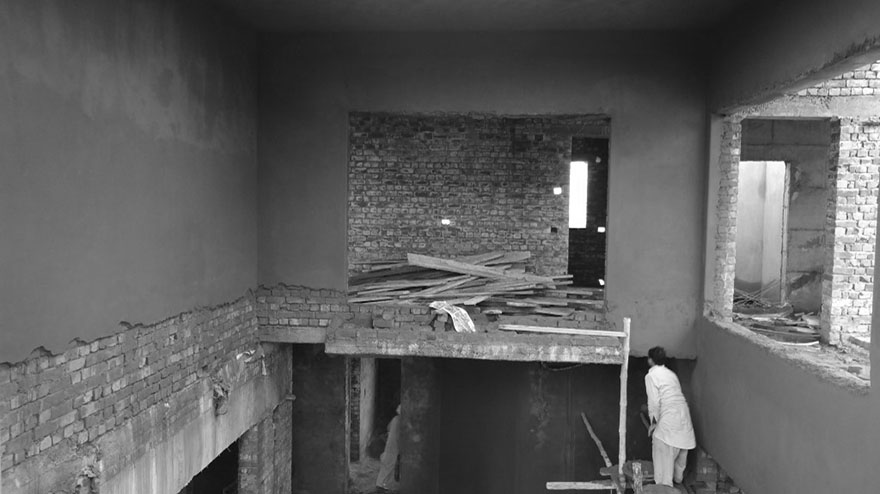
The walls of the first floor are plastered and given a smooth surface. The ratio of cement and sand used for the plaster to be applied on internal walls is 1:4. Thickness of the plaster is ½” to prepare a base to take wall finish such as paint.
61. PUBLIC HEALTH - FIRST FLOOR
Some effective waterproofing is done according to the drawings before starting public health work. Areas to accommodate the sanitary pipes are marked on the wall with chalk as per sanitary drawings. The marks are inspected by the architect before starting chiselling. Sanitary pipes are placed in the chiselled spaces. The architect inspects the position of all the sanitation pipes. PPRC water supply pipes or equivalent pipes are used. UPVC sewer water pipes or equivalent pipes are used. Effective quality local RCC pipes are used to connect to main sewer lines. Pressure and water tests are carried out to make sure there is no water leakage in the presence of the assistant construction manager who approves the test results before filling the chiselled grooves.
62. FLOORING - FIRST FLOOR
The earth is compacted. On the top of the compacted earth, a 12” thick layer of a mixture of sand and soil (kassu) is spread evenly. This layer is compacted well. A 4” thick layer of brick ballast is laid over the kassu layer. The brick ballast layer is compacted manually. All utility lines are re-inspected by the foreman before preparing the PCC base for flooring. A 1½” thick layer of PCC is poured on the brick ballast layer. This PCC layer acts as a base to take floor tiles. The ratio of cement, sand and aggregate in the PCC base is 1:2:4. Approved floor tiles are then laid on the PCC base with mortar as per drawings and instructions by the architect. The ratio of cement and sand used in the mortar is 1:6. Tiles are placed on the floor with or without the spacers as per the architect’s instructions. An accurate level of the tiles is achieved using a level with a bubble. When tiles are laid, grouting is done by filling the tiny gaps between the tiles with a specific grout.
63. BATHROOM VANITY TOP - FIRST FLOOR
¾” thick countertop of a particular material such as marble, granite or some other material is fixed on the bathroom vanity slabs that were prepared earlier.
64. BATHROOM & POWDER ROOM TILING - FIRST FLOOR
Particular floor tiles are laid on the top of a 1½” thick PCC base with mortar according to the drawings and design details. The ratio of cement and sand used in the mortar is 1:6. Accurate level of the tiles is achieved using a level before fixing the tiles in the mortar. When tiles are laid, grouting is done by filling the tiny gaps between the tiles with a specific grout. A slope is made towards the proposed floor trap while laying the tiles so water may automatically travel towards the floor trap and not stay stagnant.
65. BATHROOM FIXTURES - FIRST FLOOR
The wash basin, water closet, shower cabin, shower head, water mixers, shattaf (Muslim shower), toilet paper holder, towel rod, towel rack, floor trap, soap dish and other bathroom accessories are selected and approved by the architect and client. All the fixtures are installed and fixed following the architectural drawings.
66. INTERNAL WORKS INSPECTION
After all the internal works of brickwork, plastering, tiling, and installing fixtures are finished, the architect and assistant construction manager inspect and check for any discrepancies and amendments.
67. EXTERNAL WALL CHISELING
The external wall is chiselled along the chiselling of the internal wall to prevent any discrepancies. The assistant foreman is required to make sure that spaces to be chiselled are marked on the walls with the help of chalk following the drawings. These marks are inspected and checked by an architect before chiselling. Chiselling is not to be started without the checking of the chalk marks. After chiselling, service pipes are placed inside the grooves and spaces. The architect inspects the pipe network before it is to be covered and filled with plaster.
68. EXTERNAL WALL PLASTERING
External walls are plastered to prepare a base for external wall finish. Plaster has a cement, sand ratio of 1:3. Thickness of the plaster is ½”. The assistant foreman is required to remain at the site during plastering and check the verticality and horizontality of the wall plaster with the help of a straight edge.
69. EXTERNAL PLASTER INSPECTION
When the plastering of the external walls is complete, work is checked by the architect and assistant construction manager to ensure the same level of plaster on all surfaces without any bumps and unevenness and work is done accurately.
70. SEWER SYSTEM
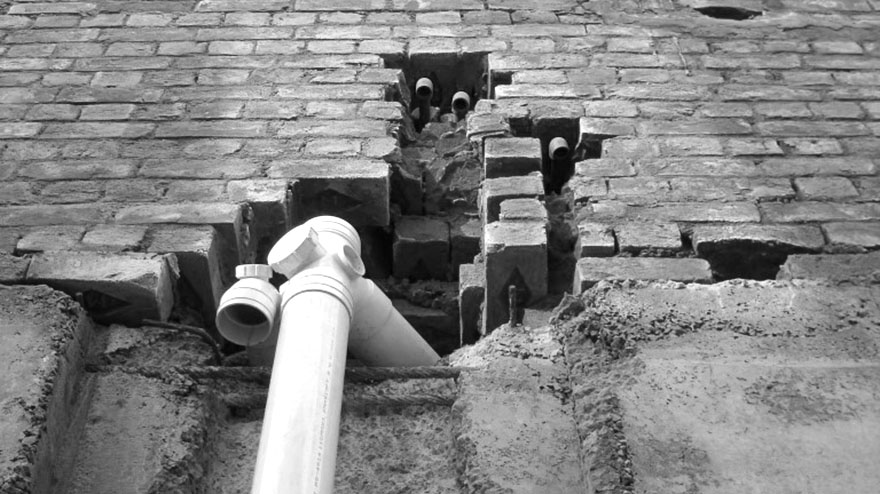
Sewer pipes are laid after all the internal sewer and wastewater piping has been completed. RCC sewer pipes or equivalent pipes are used for main sewerage lines according to the specifications given by the public health engineer. Testing and commissioning of the pipes is performed to make sure future operation of pipes will be safe, secure and without any risk. Sewer pipes are laid from the septic tank to the building to maintain the correct invert levels of the pipes. The invert level of a pipe is the bottom level of the inside of the pipe or the floor level of the pipe that determines the flow of fluid in the piping system. For a proper flow, fluid flows from a higher level to a lower level with a constant gradient. A water test is performed before filling and covering the pipes to prevent mistakes and leakages. The assistant foreman is present at the site during this task. The sewer piping system is inspected by the architect and assistant construction manager.
71. WATER SUPPLY
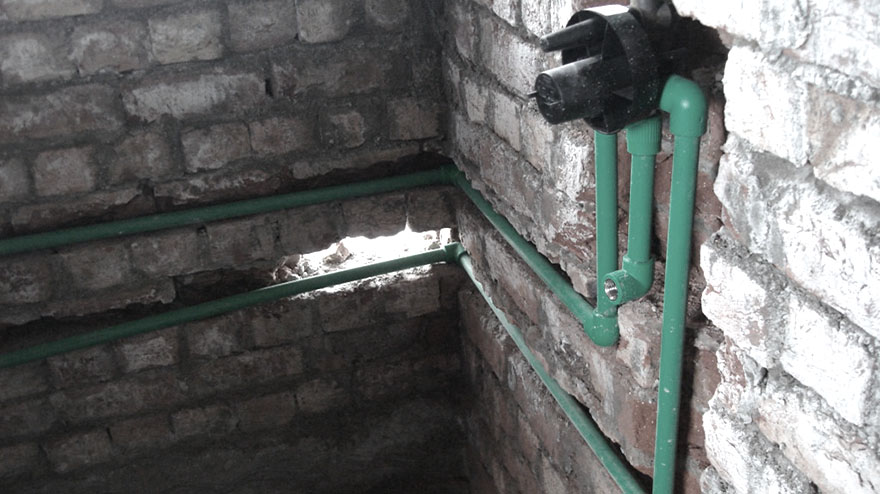
Water supply pipes are laid in the chiselled spaces and grooves (jhari) according to the specifications given by the public health engineer. The water test is performed before filling and covering the pipes to prevent mistakes and leakages. The assistant foreman is present at the site during this work. The water supply piping system is inspected by the architect and assistant construction manager.
72. ELECTRIFICATION WORKS
Electrical wiring is pulled through the conduit pipes and the distribution board (DB) is installed according to the specifications given by the electrical consultant. Earthing is done by an electrical contractor as specified by an electrical consultant in the presence of the assistant foreman. Earthing is the process of transmitting the immediate electrical energy discharge directly to the earth using wires with low resistance. Earthing is required for the safety of human life from electric shock and death. It is also required for the protection of buildings, appliances and machinery by avoiding the flow of excessive current in case of short-circuit. The electrical contractor will be responsible for the safety of all workers at the site.
73. GAS SUPPLY
PE or GI gas supply pipes or equivalent are laid in the chiselled spaces according to the instructions of the public health engineer. The assistant foreman is required to make sure that spaces to be chiselled are marked on the walls with the help of chalk following the drawings. These marks are inspected and checked by an architect before chiselling. Chiselling is not to be started without checking the chalk marks. After chiselling, service pipes are placed inside the grooves and spaces. The architect inspects the pipe network before it is covered and filled with plaster.
74. SEPTIC TANK
A septic tank is constructed according to the public health drawings and specifications issued by a public health consultant. Best-quality bricks, cement, sand and aggregate are used in making the tank. A water test is performed before covering to prevent leakage and errors. The assistant foreman is required to be present at the site during this work.
75. UGWT
The underground water tank is constructed according to the public health drawings and specifications issued by a public health consultant. Best-quality bricks, cement, sand and aggregate are used in making the tank. The water test is performed before covering to prevent leakage and errors. The assistant foreman is required to be present at the site during this work.
76. KHURA
Slightly depressed squarish, rectangular or similar-shaped spaces are formed for the collection of water, also called khuras. They are built of PCC with cement, sand and an aggregate ratio of 1:2:4.
78. COMPOUND WALL OR BOUNDARY WALL
A compound wall or boundary wall is constructed all around the house on the edges of the plot to mark the boundary of the plot according to the architectural detailed drawings. The foundation of the boundary wall is built following the structural design issued by a structural engineer. The boundary wall is built of brick masonry using mortar with cement and sand ratio of 1:4. Chiseling is carried out according to the drawings. Walls are then plastered with a 1:3 ratio of cement and sand having a thickness of ½”.
79. DRIVEWAY | RAMP | PASSAGES
PCC base is prepared for driveway, car porch, gate ramp and side passages according to the architectural drawings. The ratio of cement, sand and aggregate in the PCC base is 1:2:4. Selected floor tiles or pavers are fixed and a gradient or slope is created in the floor finish for effective water flow. Gully traps and strip drains are installed according to public health drawings and specifications.
80. MAIN GATE
The main gate is installed and supported by hinges according to architectural drawings. It can be a swinging gate or a sliding gate depending on the space and design prepared by the architect. Steel is usually used for manufacturing the gate.
81. EXTERNAL WORK INSPECTION
After all the external works are completed, the architect and assistant construction manager inspect all exterior spaces for any discrepancies or pending tasks.
82. INTERNAL PAINT BASE FINISH
A primer coat of the desired paint is applied to the internal walls. Two further coats of paint are applied by paint brush or paint roller depending on a particular textured finish. A good quality matt emulsion paint is employed for walls and ceilings of all the internal spaces except for bathrooms and powder room. A particular enamel paint, oil-based paint, is used for walls and ceilings for bathrooms and powder rooms.
83. EXTERNAL PAINT BASE FINISH
A particular graffiato base and fillings are applied on the exterior walls of the building following the manufacturer’s instructions. Graffiato is available in many different colours and textures to select from.
84. WINDOW FRAMES
Some good quality Aluminium window frames are fixed into the openings left for windows. There is a variety of colours available in the market for Aluminium profiles used for window frames. The warranty and specifications of Aluminium frames are given by the manufacturer.
85. WINDOW GLASS FIXING
Glass panels are fixed into already installed Aluminium window frames using rubber gasket seals. Silicon is filled in the spaces wherever required. The warranty and specifications of glass panes are given by the manufacturer.
86. WINDOW GRILLS
Grills are installed into window frames for the protection of glass and security from theft. Details and specifications of the steel grill are given by the manufacturer.
87. DOORS INSTALLATION
The frames of the doors are installed as per the specifications given by the manufacturer. Doors are fixed into the frames with hinges. The design of the door leaf, hinges and door knobs is determined by the architect.
88. KITCHEN WOODWORK
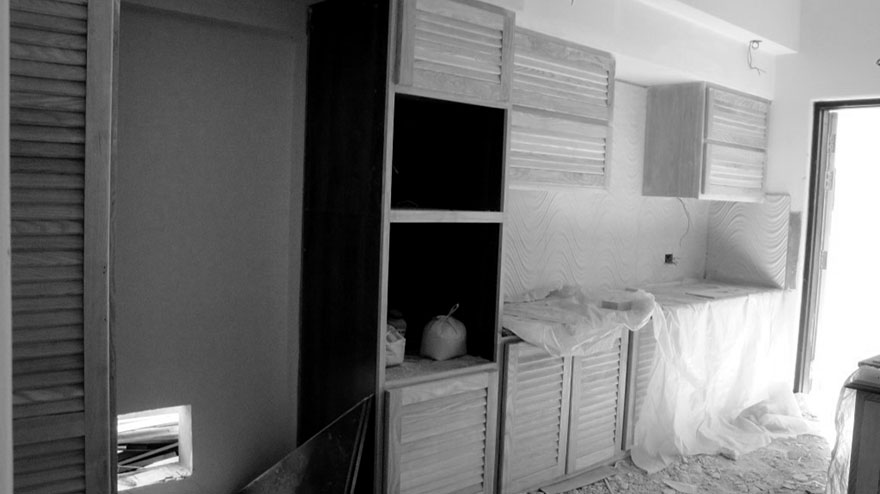
Good quality laminated chipboard boxes or MDF panels are prepared for the cabinets of the kitchen. PVC panels, MDF panels or glass panels with different colours and textures are used for the shutters of the cabinets. Shutters are fixed with the internal laminated cabinet boxes with hinges. They may be swinging or sliding according to the design.
89. WARDROBE WOODWORK
Good quality laminated chipboard boxes or MDF panels are prepared for the wardrobes in the bedrooms. PVC panels, MDF panels or glass panels with different colours and textures are used for the shutters of the cabinets. Shutters are fixed with the internal laminated cabinet boxes with hinges. They may be swinging or sliding according to the design.
90. HANDRAIL & TERRACE RAILING
The handrails of the stairs and terrace railing are fixed according to the design by the architect. They may be built of different materials such as glass, Aluminium, wrought iron or wood.
91. FINAL PAINT FINISH
The final touch of paint is applied on all the exterior and interior walls and ceilings of the building to have a smooth and tidy appearance of the finished surfaces.
92. EXTERIOR LANDSCAPE
The exterior landscape design is provided by the architect and is built according to the drawings provided. For a proposed water feature, proper waterproofing is required. Specified trees, shrubs and ground covers are planted as per the approved plan.
93. MAIN GATE PAINT
The main gate is given a specified paint finish of approved colour and texture.
94. FINISH
The project is constructed successfully. All material requisitions, approved bills, site reports and approvals by the architect and assistant construction manager are recorded and submitted to the client.











COMMENTS
Wow thats amazing
Hi there! This is some nice work, I have checked all the necessary topics that I need and was really amazed that I found all related to them very quickly. I have also found this amazing website that teaches for free and also provides free solutions. make sure you check them as well.
Hi,There it was nice that i read about the Electrical Building Design over this website and it really does help me a lot. wishing you best and I hope you will keep updating with such delightful resource
Nice post! And useful information you shared while design you home you need to pick the right Architect and Contractor to look your house good.syed brother lahore
Wonderful bloggers like yourself who would positively reply encouraged me to be more open and engaging in commenting.So know it's helpful.home construction ideas in pakistan
Super explanation. wonderful input, as always, much gratitude.lahore construction
Thank you for wonderful blog!!whether you are after a simple single, you will need an architect to expertly guide you through the design, planning and construction process.builders and developers in islamabad
Useful submit! I really want this sort of article.. that is very beneficial for me.